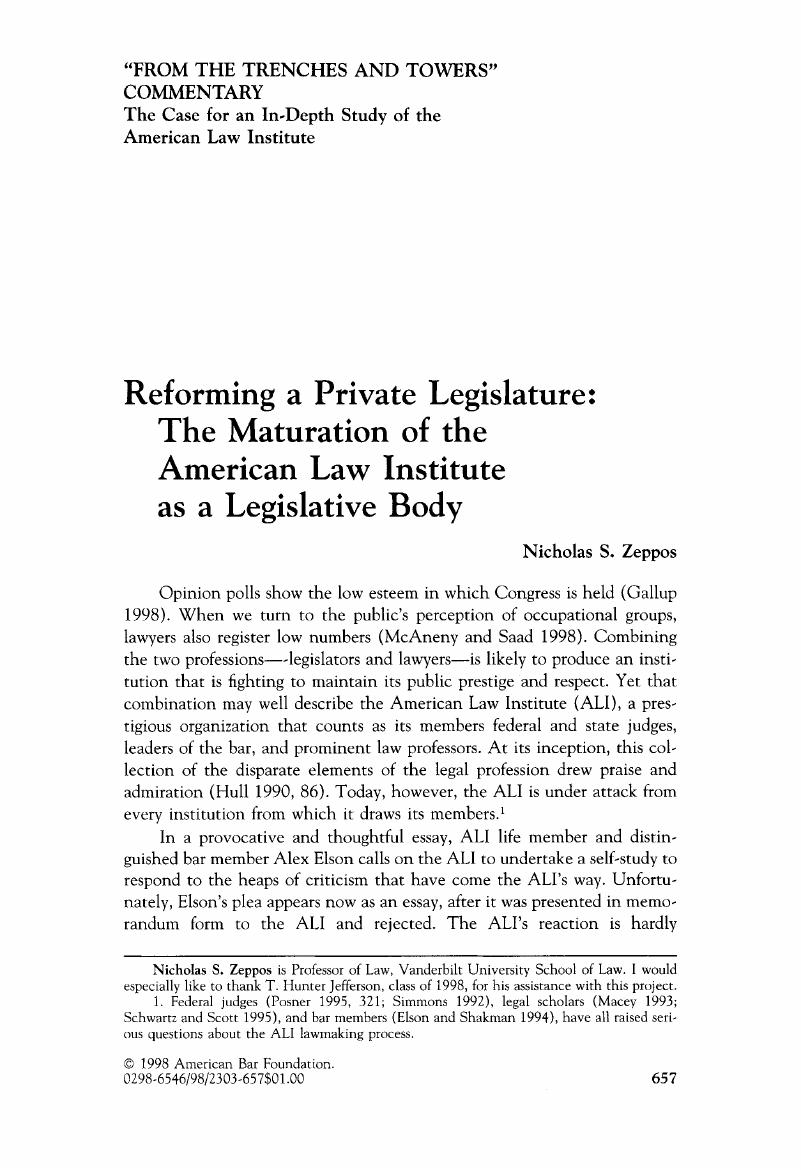No CrossRef data available.
Article contents
Reforming a Private Legislature: The Maturation of the American Law Institute as a Legislative Body
Published online by Cambridge University Press: 27 December 2018
Abstract
An abstract is not available for this content so a preview has been provided. Please use the Get access link above for information on how to access this content.

- Type
- “From the Trenches and Towers”
- Information
- Copyright
- Copyright © American Bar Foundation, 1998
References
Ahel, Richard L.
1989. American Lawyers. New York: Oxford University Press. “Congress as Employer.” 1996 Washington Post, 26 November, A14, final edition.Google Scholar
Easterbrook, Frank H.
1983. Statutes' Domains. University of Chicago Law Review
50:533–52.Google Scholar
Elson, Alex. 1998. The Case for an In-Depth Study of the American Law Institute. Law and Social Inquiry
23(3):625–40.Google Scholar
Elson, Alex, and Shakman, Michael L.
1994. The ALI Principles of Corporate Governance: A Tainted Process and a Flawed Product. Business Lawyer, 49:1761–92.Google Scholar
Friedson, Eliot. 1983. Professional Powers: A Study of the Institutionalization of Formal Knowledge. Chicago: University of Chicago Press.Google Scholar
Galanter, Marc, and Palay, Thomas. 1991. Tournament of Lawyers. Chicago: University of Chicago Press.Google Scholar
Gallup Organization. 1998. Congress Job Approval. <http://198.175.140.8/Gallup_Poll_Data/ratecong/jobapp.html>..>Google Scholar
Goldstein, Elliot. 1993. CORPRO: A Committee That Became an Institution. Business Lawyer, 48:1333–36.Google Scholar
Green, Justin J., Schmidhauser, John R., Berg, Larry L., and Brady, David. 1973. Lawyers in Congress: A Fresh Look at Some Old Assumptions. Western Political Science Quarterly, 26:440–52.Google Scholar
Hart, Henry M. Jr., and Sacks, Albert M.
1994. The Legal Process. Edited by William, N. Eskridge Jr. and Philip, P. Frickey. Westbury, N.Y.: Foundation Press.Google Scholar
Heinz, John P., and Laumann, Edward. 1982. Chicago Lawyers: The Social Structure of the Bar. New York: Russell Sage Foundation.Google Scholar
Hull, N.E.H.
1990. Restatement and Reform: A New Perspective on the Origins of the American Law Institute. Law and History Review 855–96.Google Scholar
Kalt, Joseph P., and Zupan, Mark A.
1990. The Apparent Ideological Behavior of Legislators: Testing for Principal-Agent Slack in Political Institutions. Journal of Law and Economics
33:103–31.Google Scholar
Karlan, Pamela S.
1997. Loss and Redemption: Voting Rights at the Turn of the Century. Vanderbilt Law Review, 50:291–323.Google Scholar
Landis, James M.
1938. The Administrative Process. New Haven, Conn.: Yale University Press.Google Scholar
Larson, Magali S.
1977. The Rise of Professionalism: A Sociological Analysis. Berkeley: University of California Press.Google Scholar
Macey, Jonathan R.
1992. Organizational Design and Political Control of Administrative Agencies. Journal of Law, Economics, and Organization
8:93–110.Google Scholar
Macey, Jonathan R.
1993. The Transformation of the American Law Institute. George Washington Law Review
61:1212–32.Google Scholar
Magee, Stephen P., Brock, William A., and Young, Leslie. 1989. Black Hole Tariffs and Endogenous Policy Theory: Political Economy in General Equilibrium. New York: Cambridge University Press.Google Scholar
McAneny, Leslie, and Saad, Lydia. 1998. “Honesty & Ethics Poll: Pharmacists Strengthen Their Postion as the Most Highly Rated Occupation. Gallup Organization. <http://198.175.140.8/POLL_ARCHIVES/971213.html>..>Google Scholar
McCubbins, Mathew D., Noll, Roger G., and Weingast, Barry R.
1987. Administrative Procedures as Instruments of Political Control. Journal of Law, Economics, and Organization
3:242–77.Google Scholar
Niskanen, William. 1971. Bureaucracy and Representative Government. Chicago: Aldine, Atherton.Google Scholar
Olson, Mancur. 1971. The Logic of Collective Action. Cambridge: Harvard University Press.Google Scholar
Parsons, Talcott. 1968. Professions. International Encyclopedia of the Social Sciences
12:536.Google Scholar
Pitkin, Hanna F.
1967. The Concept of Representation. Berkeley: University of California Press.Google Scholar
Posner, Richard A.
1983. Statutory Interpretation–In the Classroom and in the Courtroom. University of Chicago Law Review
50:800–822.Google Scholar
Posner, Richard A.
1993. The Material Basis of Jurisprudence. Indiana Law Journal
69:1–37.Google Scholar
Posner, Richard A.
1995. Proceedings of the American Law Institute. Philadelphia: American Law Institute.Google Scholar
Powell, Michael J.
1993. Professional Innovation: Corporate Lawyers and Private Lawmaking. American Bar Foundation Journal
1993:423–52.Google Scholar
Rosen, Robert E.
1989. The Inside Counsel Movement, Professional Judgment and Organizational Representation. Indiana Law Journal
64:479–553.Google Scholar
Rubin, Edward L.
1993. Thinking Like a Lawyer, Acting Like a Lobbyist: Some Notes on the Process of Revising UCC Articles 3 and 4. Loyola of Los Angeles Law Review
26:743–88.Google Scholar
Rubin, Paul H., and Bailey, Martin J.
1994. The Role of Lawyers in Changing the Law. Journal of Legal Studies
23:807–31.Google Scholar
Schwartz, Alan, and Scott, Robert E.
1995. The Political Economy of Private Legislatures. University of Pennsylvania Law Review, 143:595–654.Google Scholar
Senate Rejects Campaign Finance Amendment. 1997. New York Times, 19 March, B9, late edition.Google Scholar
Shamir, Ronen. 1995. Managing Legal Uncertainty: Elite Lawyers in the New Deal. Durham, N.C: Duke University Press.Google Scholar
Simmons, Paul A.
1992. Government by an Unaccountable Private Non-Profit Corporation. Journal of Human Rights
20:67–105.Google Scholar
Stewart, Richard B.
1975. The Reformation of American Administrative Law. Harvard Law Review, 88:1639–1813.Google Scholar
White, J. Michelle
1992. Legal Complexity and Lawyers' Benefit from Litigation. International Review of Law and Economics
12:381–95.Google Scholar




